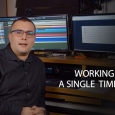TIPS ON PREPARATION FOR A RECORDING SESSION

The main objective of this article is to offer advice to young composers in their preparation for a recording session with a symphony orchestra.
1. THE SCORE – The well prepared full score of your symphonic work is the main requirement for a successful recording session. A clearly marked score saves recording time as it offers easily understandable and legible parts for the conductor and performers. Make sure that all transpositions of the instruments are correct, Horns in F, Trumpets in Bb, etc. Bear in mind that in Bulgaria the trumpet tradition is mostly playing in Bb. That means that using Bb trumpets is going to provide better sound and better intonation than using C trumpets. Certainly, if you prefer the bright sound of C trumpets, this is completely doable.
The next important point is to follow the best traditions in notating the rhythmic texture in a most clear way. Do not forget that the orchestra players see their parts for a first time at the recording session. To save your time and facilitate the musicians’ work, make sure you notate your score with visually well-organized rhythm and beats.
Example - Correctly written:
This is exactly the same, but much harder for reading:
Recently composers write first and third horn in one staff and second and fourth horn in another one. All scores from Beethoven to John Adams are written in the following way: horns 1 and 2 in one staff, and 3 and 4 in another. Keeping this tradition is another very useful way to save time and facilitate the recording process.
2. THE PARTS – Parts preparation is another very important aspect, unfortunately often neglected. A lot of composers simply extract the parts from the score in Finale or Sibelius notation software, not considering that the parts for woodwinds and brass should be separated for every single player. Shared parts, as first and second flute on one staff, are extremely difficult to read. This will take precious time from the recording session. The percussion section and the choir are the two exceptions of this rule. You can make a separate score for the percussion group, or the choir, containing all instruments or voices.
3. CLICK TRACK/TEMPO MAP – Using your session time efficiently depends also on your well prepared click track. First of all, put two empty bars at the beginning of the click track, to give the tempo to the orchestra and the conductor. If the tempo is very fast, it is better to put four empty bars. Notate these extra bars in the score as well. Make sure that the bar numbers in the score and the bar numbers in the software are synchronized.
4. SAMPLES AND STEMS – If your project contains samples, export the different orchestra sections in different stems. This will provide the option of combining the stems as needed for each section of the orchestra. For instance: while the string section is recording, they will be able to listen to the brass and woodwinds only, making it easier for them to adjust intonation and rhythm.
If you are using samples in your project, then the orchestra probably has to tune A4 at 440Hz, because most of the sample libraries are recorded at 440Hz. If you don’t use samples in your project, you can choose between 440Hz or 442Hz. Keep in mind that for woodwinds and brass it is more natural to tune at 442Hz, as they are used to playing in this tuning in their daily work. For strings - it doesn’t really matter.
5. RECORDING ORDER – Schedule the recording order of your pieces according to the difficulty and priority of the music. Usually musicians are most productive in the middle of the session, so it is very important to use your time wisely. Schedule the hardest and most important music for the middle of the session. The beginning is appropriate for something not too hard, which will allow to build up concentration. At the end of the session all musicians are usually tired, leave the easiest pieces for this time.
HAVE A GREAT RECORDING SESSION!
Lyubomir Denev JR, Conductor of Sofia Session Orchestra















